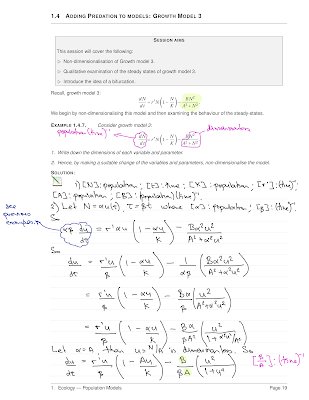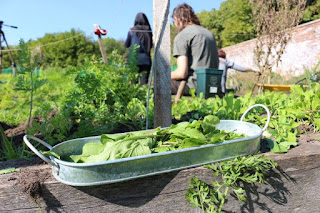By Dr Martyn Parker, School of Computing and Mathematics, Keele University
Early in my academic career, I recognised that I had fallen into the same educational traps as many of my colleagues. At this stage, I worked in a department full of blackboards, and my initial attempts at educating students were identical to my experiences as a student.A walk around mathematics departments the world over usually reveals corridors and rooms full of blackboards. It is not atypical for lecturers to fill blackboards several times over rather than use a few sketches or keywords. Other subjects use modern presentation tools and other learning methods, why not mathematics?
Completing my first year teaching in higher education made me challenged myself to provide an excellent education that confronted the traditional blackboard method of university mathematics education. The entrenched view among mathematician that blackboard ‘chalk and talk’ is the only way at university and the ease with which I followed the ‘standard path’, meant I needed to demonstrate clear benefits to both staff and students of any alternative. This journey started before I joined Keele when I recognised early in my career that emerging technologies presented the opportunity to advance my educational practices. Nevertheless, it was not until I joined Keele that I made progress in developing both my practice and that of my peers.
I joined Keele in 2010 and challenged myself to demonstrate that mathematics education did not need to use nineteenth-century tools—the blackboard (or whiteboard). In particular, I wanted to demonstrate that appropriate technology has all the (perceived) advantages of the blackboard-based methods and can improve the student experience.
Mathematics is characterised as a `network of norms’ where interconnectedness must be material manifest2 . This networking of esoteric language is one reason so many departments use blackboards/whiteboards; learners need to see and engage mathematics as a process that creates the network and interconnected relationships3. For this reason, any technology that attempts to enhance mathematics education must continue to show these abstract ideas develop4 ; that is, replacing `chalk and talk’ with `PowerPoint and talk’ is not the answer!
Several stages characterise my approach. Rather than take these stages chronologically, it is better to discuss these by area. Below I summarise these areas, provide examples, detail the tool necessary to replicate them and some of the broader impact on the department.
Technology-enhanced delivery. My modules utilise a Tablet PC with a stylus (henceforth called a Tablet, the essential characteristic is a screen and stylus that can write directly on the screen). I employed a three-component framework5 consisting of a deficit, where technology provides missing support for learning activities; substitution, where a traditional element is replaced with a technology-based activity; enrichment, where technology offers a choice that complements existing materials. Tablets immediately address the three components. Specifically, they are a substitute for traditional blackboards, replicating the best features of blackboards: speed, space, visibility and legibility. They address the deficit of blackboards by providing the ability to switch between multiple delivery methods such as videos, quizzes, information delivery and Internet web pages allowing for breaks, consolidation periods and changes of activity within the class. Once complete, class material is uploaded to the KLE. This change in practice has impacted students with specific learning disabilities positively, rather than struggling to copy content from the board, they actively listen, knowing the written component is available to them after class.
A short sample video taken from the lecture Playback demonstrating how
the static image evolved during the class. Note, the video’s sound is muted due to students
asking and answering questions. Furthermore, for brevity the video is sped up.)
Equipment requirements: A standard Tablet PC with a stylus. Microsoft Office provides annotation tools. The department utilise software called PDF Annotator since staff outputs are typically PDFs.
Departmental impact: In 2010, no staff except me utilised a Tablet for class delivery, now almost all staff now utilise a Tablet to deliver their classes. The School issues all new mathematics staff with Tablets.
Feedback. A five-minute video is likely to contain the equivalent of 500 - 600 words of written feedback, so a video provides ‘more’ feedback. This advantage, however, must be tempered with the fundamental idea that quality is better than quantity. Social changes mean greater student exposure to visual and audio media and research suggests better students response to multimodal feedback, where the tutor’s voice and the visuals convey relevant information. For students with, for example, dyslexia, students receive visual and oral information. From the mathematical perspective, video feedback permits students to experience the process of mathematical reasoning, seeing ideas materialise in front of them; that is, mathematics is visualised as a process and not a product, a key reason cited by mathematicians for blackboard use6. The videos are embedded directly into the module KLE page.
A short sample of class test feedback
Equipment requirements: A standard Tablet PC with stylus and screen recording software such as Camtasia or Snagit.
Departmental impact: The percentage of students agreeing that ‘feedback on my work has helped me clarify things I did not understand’ rose from 68% agree or strongly agree in 2010 to 81% in 2016. The 2016 result compares to a sector average of 71%. The 2017 result for `I have received helpful comments on my work’ is 89%, above the 73% sector average.
Video tutorials and problem-classes. I wanted to increase student engagement with formative assessment. Using Tablet PCs, screencast technology, YouTube and the KLE I created pre-recorded online classes. The classes’ structure consists of online tutorials, supporting formative assessment material together with online feedback on the formative assessment. Learners engage with the content at their pace and can move onto a new tutorial when they judge they have achieved particular outcomes. The aim being for students to regulate their learning.
 |
Example suite of video tutorials for a mathematics module.
|
 |
| Example tutorial videos and support materials. This tutorial covers the “Video Tutorial for Interacting Species” in the previous image. |
Equipment requirements: A standard Tablet PC with stylus and screen recording software such as Camtasia or Snagit.
Departmental impact: Other members of the mathematics department now create video tutorials for their modules. I supported and mentored staff in the use and development of materials. The department currently has 765 videos that include feedback and tutorials. The analytics demonstrate student engagement that presently stands at 108,000 minutes watched from 23,500 video views. (These videos are only available to Keele mathematics students registered on the relevant modules.)
Multimedia-based assessment. I took the Keele-led in a National HESTEM Programme Grant on ‘Mathematical Modelling and Problem Solving’. The project’s primary aim was to aim to create a sustainable model that provides STEM undergraduates with the transferable skills and abilities to solve real-world problems. To meet this aim I designed a new module where students needed to create creative instructional videos that demonstrate the solutions to problems. The grant funded video cameras with students using free software to edit their creations. Students participated in the evaluation of each other’s presentation, with the department’s academic staff acting as facilitators and possessing the final say on marks. This approach provides a variant on Adaptive Comparative Judgement (ACJ) which is relatively untested in mathematics but has been employed in less creative settings7. The ACJ variant used is appealing since it is well suited to assess creativity and I wanted to determine its applicability as a peer-assessment tool. Engagement with this assessment was phenomenal. In all cases, students not only solved complex mathematical problems but provided incredibly creative video presentations of their work.
The video cameras found a second use. The School provides these to students preparing for presentation as a self-reflection tool so that they can film, watch and reflect on their presentations, creating their formative self-assessment.
Equipment requirements: Purchasing video cameras is optional; more recently, students use their mobile phones and free editing software. There is more to say, for example, recent developments include using YouTube's live streaming facility to escape from a physical classroom. Recognising there is more to say and looking back reveals the ever-changing ability for technology to enhance both the student and staff experience. The enhanced student experience is summarised by the words of a current student's response to their learning experience that "...brings Keele maths department into the 2010s." For me, technology has improved not only my practice, not only regarding student education but also my ability to effectively focus on education rather than just writing. It is worth closing by reminding ourselves that technology is one of many tools available to us and we must always be mindful of the words "the right tool for the right job".
1Phhere. (2017). The free high-resolution photo of writing, blackboard, math, research, text, handwriting, mathematics, lecture, presentation, insight, chalk board, abstract algebra, critical thinking, definitions, propositions, deductive reasoning. [Online] Available from: https://pxhere.com/en/photo/973959 Accessed: 14 February 2018.
2Wittgenstein, L. (1978). Remarks on the Foundations of Mathematics. Oxford:Basil Blackwell.
3Mason, J. (2002). Mathematics Teaching Practice: A Guide for University and College Lecturers. UK: Horwood Publishing Limited.
4D. O. Tall, D. O. and Mejia-Ramos, J. P. (2006). The long-term cognitive development of different types of reasoning and proof. In Hanna, G., Jahnke, H. N., and Pulte, H., editors, Conference on explanation and proof in mathematics: Philosophical and educational perspectives, pages 1 – 11. Universiat Duisburg-Essen, Campus Essen.
5Thorne, K. (2003). Blended learning: How to integrate online and traditional learning. Kogan Page, London.
6Greiffenhagen, C. (2014). The materiality of mathematics: Presenting mathematics at the blackboard. The British Journal of Sociology, 65(3):502–528.
7Jones, I. and Alcock, L. (2012). Summative peer assessment of undergraduate calculus using adaptive comparative judgement. In Iannone, P. and Simpson, A., editors, Mapping University Mathematics Assessment Practices, chapter 17, pages 63 – 74. University of East Anglia.

My experiences with technology-enhanced learning, B by y Martyn Parker, School of Computing and Mathematics, Keele University is licensed under a Creative Commons Attribution-ShareAlike 4.0 International License.










